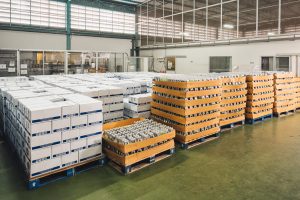Pest Management is one of the critical HACCP pre-requisite programs (PRPs) which support site Good Manufacturing Practices (GMP). A review of the last SQFI audit statistics shows that pest control requirements are at the top list of major non-conformities. A pest management program within a food storage or manufacturing facility involves monitoring pests including insects, rodents, and maybe birds. Depending on the type of food handled on-site, the species of insects may be different. For instance, beverage manufacturers may encounter a lot of flying insects such as fruit flies, flies, and wasps. In a mill or bakery, crawling insects may be found such as flour beetles and their larvae as well as Indian meal moths. Control strategies must therefore also be different.
Pest control management programs are often subcontracted. This means that SQF practitioners need to liaise with pest control technicians and other specialists. The typical pest control contract excludes any bird dispersal strategies unless there is an acute need to implement controls (such as if birds are nesting under the building eaves or on the roof). Pest management services may include twice-a-year visits from a quality assurance consultant (most often an entomologist) to expertly tour the facility, review pest control documentation, and provide guidance. These levels of services are usually offered when facilities seek HACCP or GFSI certification.
Trained pest control service technicians are competent to handle rodent bait and other controlled chemicals and so must possess a pesticide applicator license. They may need to spot-spray areas of the site or in the event of an infestation, fumigate the whole building. Their job description entails communicating with the SQF practitioners and monitoring on a weekly or monthly basis pest control devices such as rodent or pheromone traps, glue boards, and bait stations. They are also responsible for touring the facility and outside grounds and noting any evidence of pest activity, any missing rodent trap, or areas in need of repair, housekeeping, or cleaning.
Considering that food spills and waste are pest attractants, it is advised to keep outside waste receptacles covered. Similarly, a vegetation-free zone around the building perimeter should be maintained to prevent pest harbourage. It’s also important to note that pooling water will attract birds and rodents so should be addressed. Inside the facility, employees must be reminded that lunches shall not be stored in lockers. Lunchrooms must be kept sanitary. The implementation of good sanitation and waste handling practices are consequently critical to keep pests away from the building and from food.
The building perimeter must be well sealed to prevent pest ingress. Common pest access points include the roof (through air vents, extractor fans), unsealed openings, cracked foundations, or torn screens. They also include improperly sealed bay doors, man doors, and windows. At shipping and receiving doors, air curtains or screens may be used to prevent the entry of pests into the building. Contractors must make a point to relay observations to SQF practitioners via their service reports and also verbally. Shadowing the contractor once or twice a year is a very good way for practitioners to become aware of GMP gaps that may create a food safety issue. It is also important that practitioners be trained on GMP programs including the monitoring and verification of such programs. In addition to their HACCP certificate, they should attend GMP training.
Evidence of Activity
During an SQF audit, whether announced or unannounced, evidence of pest activity left unaddressed will automatically lose points from the overall audit score. The presence of rodent droppings in warehousing areas, chewed packaging materials and food, deceased rodents in traps, or a full infestation will pose a serious food safety risk and signal to the auditor that the site is not suitable for the manufacture and storage of food. SQF practitioners are encouraged to add to their GMP inspection checklists the following areas: perimeter doors, loading bays, bulk food upload stations, ceilings (high beams and suspended ceilings), and other elevated areas. Staff authorized to conduct GMP inspections must look for the presence of insect trails and rodent tracks at the base of flour silos, on lower walls in pallet racking areas, on ceiling beams, and on overhead piping and conduits. SQF auditors are known to notice spider webs on overhead pipes and equipment. This denotes that the master sanitation program is not complete and that elevated areas are not included in the program scope.
Black light test and other rodent tracking devices
Pest service technicians and shipper receivers will sometimes carry with them black lights to monitor the top of pallets and bagged ingredients. These devices are used to detect rodent contamination. Rodent urine will show blue/white to yellow/white fluorescence when viewed under black light. The black light test can be conducted to detect stains on food bags, containers, or floors. It can be carried out prior to unloading a truck. Other innovative tools like HACCP-compliant fluorescent tracking dusts and gels are also available.
Pest control devices and controlled chemicals
There are a number of common pest control devices used by the industry. Live rodent traps are referred to as “KetchAlls” and “Tincats”. Glue boards, insect lights, and bird spikes are also used. When dealing with grains, flour, or seeds, pheromone traps may be installed to monitor Indian meal moths. In keeping with good practices, snap traps are not permitted in the facility as they are not hygienic. Peanut butter or cheese must not be used as bait in traps because they are allergens. Pesticides and rodenticides, if stored on the premises, must be kept away from food manufacturing and storage areas. If they are stored at the plant, they should be secure. Finally, facilities that seek an organic certification are not permitted to use conventional pest control chemicals onsite. Discuss alternative strategies with your pest control service provider.
Maintaining a Pest Control Program for SQF
The SQF code for food manufacturing, Edition 91 lists ten bullet point requirements for pest control management. Element 11.2.4 requires that a documented pest prevention program be effectively implemented. This program includes:
- Map of pest control devices including insect lights, pheromones, and rodent traps.
- Pest Monitoring procedures including verifications and corrective actions
-Responsibility, Frequency of pest monitoring procedures - Instructions for controlled chemical usage, storage, and disposal
-Pest control awareness procedures for facility employees including “measures to take when they come into contact with a bait station” - Documentation of pest sightings and recording of pest control trends (a minimum of quarterly)
- Insurance policy, licenses for lead and backup pest control personnel
- Chemical SDS/MSDS sheets, Specifications, and Labels
- Record-keeping
When approving a new pest control service provider, SQF practitioners should communicate the above SQF site requirements to the prospective pest control service provider. This establishes the advanced level of service which is expected at the facility.
In conclusion, scoring full marks on your next SQF audit should not be difficult. It necessitates a good cleaning and housekeeping program, a reliable pest control service provider, and approved suppliers who maintain good GMPs. As with any other HACCP pre-requisite programs, verification of program effectiveness is key. The SQF practitioners must be trained and perform frequent GMP inspections and thorough record reviews of the pest management program and other PRPs to do well on their certification audit.
Sirocco Food + Wine Consulting provides certification audit consulting services (HACCP, SQF, GMP) to Canadian and US food companies and storage facilities. We also offer for sale detailed SFCR and SQF document packages for the creation of HACCP, SQF, and GMP manuals. Contact us for more information or to obtain a quote.
References:





